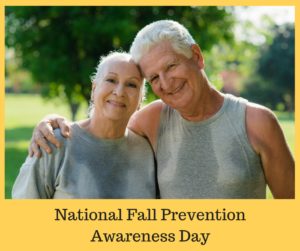
September 22nd 2017 is National Fall Prevention Awareness Day. So what better time to address this common concern among the aging adult population? Research shows that >30% of individuals over the age of 65 fall every year. This makes falling the number one common cause of injury and accidental death among this age population, according to the Centers for Disease Control and Prevention. Falls and the fear of falling can cause considerable complications with maintaining independence and community participation, in addition to being tied closely to multiple other medical issues (osteoporosis, diabetes, cardiovascular disease) that result from declining activity and utilization of assistive devices such as walkers and wheelchairs.
Here is a list of several factors that can either contribute to or reduce a person’s fall risk, as well as some strategies to improve in these areas:
Balance– One of the most common reasons for a fall is a declining sense of balance and steadiness while standing and walking. Loss of balance is related to a combination of factors which can include limitations in vision, proprioception (the body’s ability to successfully communicate with itself to be aware of position in space), vestibular health (coordination of eye and body movement with inner ear sense of equilibrium), and strength. Maintaining a baseline level of activity as well as working on balance training with a physical therapist, can be significantly fall prevention measures.
Vision– Declining vision and reduced awareness of fall hazards (curbs, steps, changes in surface) can lead to tripping or other precarious situations. Vision is also a major component of our general balance, and regular eye exams and monitoring of appropriateness of any prescriptive lenses can assist with reducing this risk.
Strength– An improved ability to control body weight in space, as well as increased general strength of both the core and the legs can significantly reduce fall risk by providing a more stable base of support. General body strength can also reduce reliance on assistive devices. As functional movement specialists, physical therapists are great resources for assessment of your current abilities and for creating a plan to improve your function. A physical therapist can also help you to establish an exercise program to enable you to reach your activity goals.
Medication– A common side effect of many medications is dizziness. Many medications also create other symptoms that can significantly increase fall risk. It is a good idea to regularly review your medication list with a doctor as well as to inquire about risks and side effects when given any new prescription.
Symmetry Physical Therapy cares about your safety and successful independence. Our therapists are well skilled in evaluating your current fall risk and can work with you to set up an individualized plan to improve your balance, strength and endurance so that you can continue to live a healthy and active life. If you have had a recent fall, are increasingly afraid of falling, or simply need some guidance on appropriate ways to continue to exercise and maintain independence, let’s celebrate National Fall Prevention Awareness Day together! Contact us today at 512-339-1500 to schedule an evaluation.
